Since taking charge of Brighton in late September, Roberto De Zerbi has picked up right where Graham Potter left off, continuing the team’s excellence in and out of possession. The results haven’t always followed despite all the positives in their performance, but De Zerbi seems to have found solidity now, with the Seagulls currently sitting in seventh place. Here is our tactical analysis of De Zerbi’s Brighton so far in 2022-23, and whether or not the Italian can lead them toward European football this season.
SYSTEM OF PLAY: 4-2-3-1

Amidst all the complexity of Graham Potter at Brighton, De Zerbi has stayed relatively rigid in operating in the bounds of a 4-2-3-1. The Italian initially started off in the 3-4-2-1 that Graham Potter utilized to climb inside the top five before his departure, but the team now look settled in that back-four.
Perhaps the most interesting move of De Zerbi’s time in charge has been repurposing Pascal Groß into a right-back, a position he only occasionally played in for Potter. Groß started the season off wonderfully well up and down those right-half-spaces as an attacking midfielder, but has only continued his fine scoring form from his new fullback position.
Embed from Getty ImagesPervis Estupiñán has been a more obvious starter down the left, and operates like an out-and-out wing-back as he gallops and gallivants up the left wing. In between the pair of experimental fullbacks is a robust partnership between Lewis Dunk and Adam Webster – two exceptional, towering, imposing defenders. Levi Colwill has come into the fold in recent weeks due to an injury to Webster, and has looked fully comfortable operating in De Zerbi’s possession heavy ideologies. Joel Veltman also remains a key figurehead whenever the team play in a back-three, as he can operate as either a right-centre-back or right-wing-back. This makes him useful in a back four too if De Zerbi wants to return the versatile Groß back into midfield.
Embed from Getty ImagesIn behind the back-line just so happens to be the only man to play every single minute so far this campaign for the Seagulls – Spain’s ‘Sweeper Keeper’ Robert Sanchez. The Spaniard is excellent out from the back, and makes smart tactical decisions when rushing out from his line. He’ll continue to be key as Brighton work on sewing up their defense, and ensuring they don’t have to score a plethora of goals just to secure the victory.
Embed from Getty ImagesIn midfield, De Zerbi’s started the partnership of Alexis Mac Allister and Moisés Caicedo in every match apart from the last, after Mac Allister won the World Cup with Argentina. This has been a beautiful concoction of brilliance from the Graham Potter days, finding a way to get the best out of Caicedo’s fantastic shuttling energy without limiting him to a strictly defensive role. Playing alongside an aggressive ‘6’ who also happens to be imaginative on the ball has been a stroke of genius, and De Zerbi’s clearly recognized the value of his midfield pairing in controlling the tempo of the game. It will be interesting to see if the Italian adjusts after the fantastic form of Mac Allister as more of an explosive ‘8’ (borderline ’10’) for Argentina, although a shift away from the double-pivot may be unlikely given their success.
Embed from Getty ImagesAdam Lallana has come back into the fold as the team’s ’10’ rather than in that deeper-lying role, a move that already began earlier in the season under Potter. His creativity and attacking thrust isn’t quite what it used to be, but he remains a hard-working, boisterous presence to have in the squad. Solly March is the one who perhaps now possesses what Lallana used to be capable of doing up and down the wing, with a fantastic eye for a pass and an incisive, skillful presence on the ball.
Embed from Getty ImagesOn the other wing, you have more of a direct threat in Leandro Trossard (who also happens to love dribbling his way past opponents), or his understudy Kaoru Mitoma – who’s grown under De Zerbi since the Italian’s arrival. Danny Welbeck might remain the favourite up top when Trossard’s not already taken the mantle, but is yet to score this season. This may be where De Zerbi turns Trossard into the team’s out-and-out centre-forward, whilst utilizing the explosiveness of Mitoma to run in behind. Welbeck’s been fine holding up the ball and creating for others, but you don’t really need that type of player in a De Zerbi system if they can’t simultaneously get on the end of chances.
Embed from Getty ImagesThey already have the creative power coming from the likes of Groß, March and the left-sided rotations of Trossard and Estupiñán, so the centre-forward must be capable of finishing off chances. Welbeck’s never been the most clinical in front of goal, and Trossard simply offers more in every area of the game – from defensive aggression to on-the-ball quality. A centre-forward might remain the priority despite Brighton’s investment from the summer, although De Zerbi has shown a desire to experiment with the likes of Enciso and Sarmiento late on in matches.
While they wait for a natural goal-scoring centre-forward, De Zerbi continues to push Brighton’s charge up the table, and ensure they’re set up for a solid top half finish once more.
DEFENSIVE PRINCIPLES
Embed from Getty ImagesWhen Roberto De Zerbi first took over, the pressing principles appeared a little chaotic. Their 3-4-2-1 shifted all over the place from a 5-3-2 to a 4-4-2 to players scattered across different lines in no particular order. In some ways, that was fun. In other ways, it was difficult to truly know what to make of De Zerbi’s tactical plans in defense, which is normally more of a rigid phase than a chaotic one.
But more recently, Brighton have typically defended in the shape that you would expect from their starting formation. In the 4-2-3-1, that defensive stance shifts in between a 4-2-3-1 and 4-4-2.
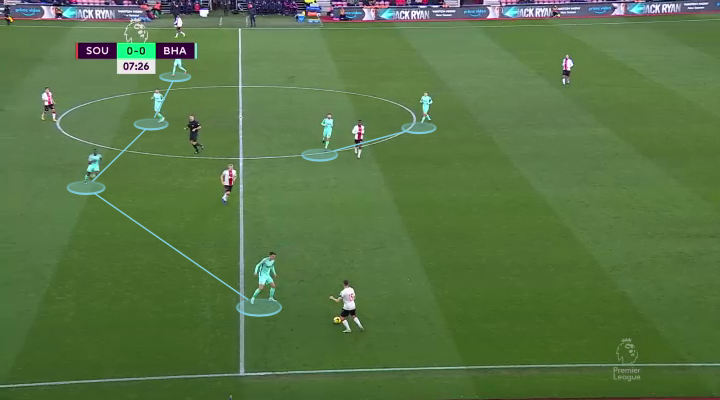
The key however is not the shape, but how they press to stop the opposition’s key players. Dating all the way back to the first match against Liverpool, Moisés Caicedo did an absolute number on Trent Alexander-Arnold, who couldn’t escape the shackles of the Ecuadorian despite his attempts to invert into midfield to receive the ball.
The desire to limit the opposition’s key players and tactical plan can mean that forwards split far apart as they press full-backs to outside centre-backs, and even at times that the central midfielders may over-compact in the quest to overload one side. While the pressing clearly has some fine-tuned notes still needing to be worked out, the electricity in their approach has never wavered. This had been the over-arching expression throughout Graham Potter’s time, and it was always likely to continue under a press and possess heavy coach like De Zerbi.
Embed from Getty ImagesIn fact, the most encouraging aspect to the Italian’s management style has been his ability to not change all that much from Graham Potter’s reign. He’s adopted much of the same principles and mindsets from Potter, and the squad have reacted brilliantly in meeting his demands.
The pressing is collective, intense, angled incredibly well, and the distances between the lines are incredibly similar. Gaps are big enough between lines that the opposition should be more incentivized toward a slower build up through the thirds (like De Zerbi wants himself), ensuring the defensive line has plenty of space to defend high balls over the top. Sanchez doesn’t even need to enact his sweeping capabilities as much as he might want, with the defensive line always remaining with a half-turned edge toward defending the longer pass. They’re not particularly bothered about keeping the opposition off-side, instead preferring to give themselves the space to properly defend against speedy attackers.
Embed from Getty ImagesWith the solid defensive stance of the back-line and the intense pressing from the forwards, the midfield pivot are then required to do most of the bulk ball-winning. Thankfully, Mac Allister and Caicedo are both excellent in reading the game and shuttling wherever required to toss themselves into the mix. The two men are currently posting up a combined 8.96 tackles + interceptions per 90 this season, with Caicedo at a particularly impressive 74% tackle rate.
Embed from Getty ImagesThe other key area of the pitch that the Seagulls love to win the ball is in the wide areas, where they will often force traffic into their defensively overloaded traps. The diamonds and triangles are something that De Zerbi looks for all across the pitch, and the energy that the team envelops helps in quickly surrounding the ball players on the ball. It’s no surprise that Veltman and Estupiñán are the next top ball-winners, with the Ecuadorian at the most impressive 86% tackle rate.
Embed from Getty ImagesGiven the already existing positional awareness of players like Dunk, Webster and Colwill, not to mention the commanding presence they naturally impose, it’s often hard to find a way past the Seagulls. The two centre-backs may even surround the same striker to ensure a better chance at winning the header, as the midfielders collapse into the box to add to the pressure.

Yet lapses in concentration and individual mistakes have meant that De Zerbi’s conceded 14 goals in his 9 matches in charge so far. Defensive reassurances remain necessary, and perhaps that will come with time as he expands his pressing horizons.
ATTACKING PRINCIPLES
Embed from Getty ImagesIt would feel wrong to start any attacking section on Brighton this season without beginning with the man who’s brought so much good fortune their way – Leandro Trossard. You’re probably expecting me to say the word left-footed in the next few sentences, but believe it or not, the Belgian wizard is actually right-footed.
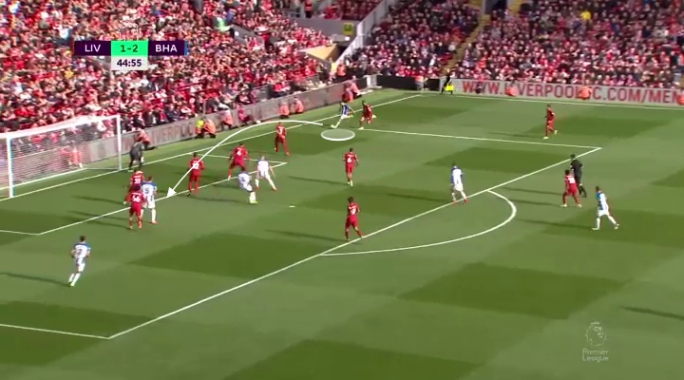
He’s just made an absolute habit of scoring left-footed goals, through a keen recognition of what foot to use in different moments. We wrote an entire analysis around Trossard’s two-footed IQ in Game of Numbers #7, but it’s worth reiterating that he’s scored 71% of his 7 goals this season (5) from his weak-foot. This is actually an anomaly across his entire career thus far, but it’s been almost entirely around his frequent occupation of the left-half-spaces, where he’s often given the ball in space on that side. He fully backs himself to finish off these chances, always shooting with tremendous power before he bulges the back of the net.
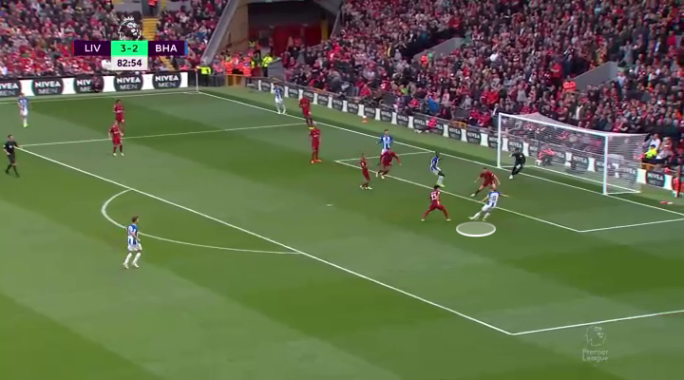
So with that eulogy out of the way, De Zerbi also deserves credit for the way he’s used Trossard since his arrival. De Zerbi has never shied away from using the Belgian as a lone centre-forward up top, taking advantage of his explosive running power and clinical finishing. Trossard has long been one of the first outlets in transition, and now his adventurous mindset can be used immediately in either channel. Playing someone equally explosive like Mitoma alongside him can continue to allow for the best to come out of Trossard’s ability on the ball, ensuring he can get on the ball deeper on the field, link up and create for others, rather than just needing to be this direct goal-scoring threat in behind.
Embed from Getty ImagesWe’ve always seen Trossard as more of the ‘Dynamic Dribbling’ type, and his on-the-ball ability should not be limited in favour of his intense running power. De Zerbi’s achieved this balance with the way he’s balanced the eleven, and it’s continued to get the best out of Trossard inside the penalty area.
Now for the particularities around De Zerbi and his build-up, which you have most likely been waiting to see! De Zerbi has prioritized short passing out from the back, often done through one-touch triangulations. One player may lull the opposition into pressing harder by pausing on the ball and delaying the action, and Brighton remain fully comfortable in playing their way out and exposing the gaps.
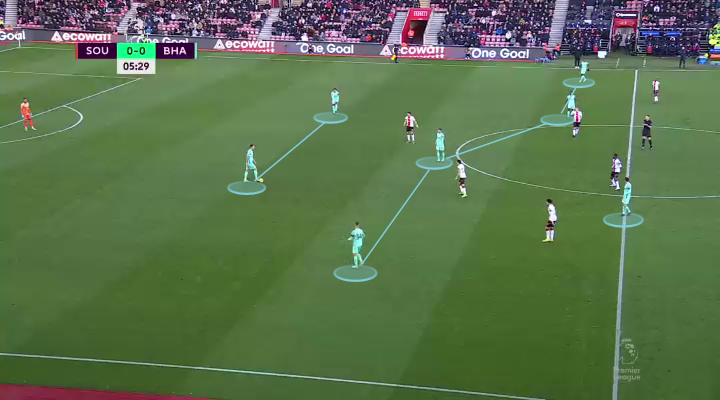
Their 3-4-2-1 shape will frequently see more of a 3+2 build-up, but now in the 4-2-3-1, a 2-4-4 is the most common adoption. The one slight intricate innovation sees Pascal Groß shift inside as an ‘Inverted Fullback’, as March comes deeper to receive in more of a 2-5-3. But that 2-4-4 is most likely to hold true, with the quartet of the centre-backs and central midfielders in incredibly close proximity to work their short passing one-touch magic. Beyond the ability to work these one-touch maneuvers, deploying the midfielders so close to the defensive line often pulls the opposition with those players, opening more space to play progressive passes in behind.

It helps that Caicedo and Mac Allister are quite formidable under pressure, and seemingly can pass their way around any situation. Both are excellent progressors when they aspire to be, but are also smart about recycling and going backwards instead, taking the safer options as they work to maintain possession.
Robert Sanchez always remains involved as a passing option out from the back, and plays his part as that free man full of composure. He’s completed 99% of his short passes and 98% of his medium passes, which remains immensely impressive even for a goalkeeper.
Embed from Getty ImagesThe desire within this shape is to compact the opposition into a false sense of security in pressing the middle, before their wide overloads take center stage as they progress. Brighton will build up almost one third and one line at a time, and do not want to rush the ball forward if it’s not the right moment. So as they play through those central compactions, they can then see the fullback, wing, and midfielders combine in the wide areas to create more magic going forward.
The left-side has been where they’ve achieved a lot of nice overloads through the adventurous Ecuadorian pairing of Caicedo and Estupiñán, where the two men can combine with Trossard or Mitoma down the left and wreak havoc. Estupiñán likes to get up the by-line and deliver crosses, and the direct running power of Mitoma and Trossard can also be used as instant outlets in those channels.

Solly March is a fantastic crosser of the ball down the other wing, and an incredibly skillful player who can create his own sense of space for himself before delivering.
So while Brighton have conceded more than their fair share of goals since De Zerbi took over, they’ve also bagged 15 in his 9 matches, ensuring they at least end the day with a positive goal-difference. They remain an incredibly fun side to watch going forward, and this is all we could have possibly asked for of Graham Potter’s successor.
CONCLUDING THOUGHTS
Embed from Getty ImagesRoberto De Zerbi has not enjoyed the perfect start since he moved to Brighton, but the players are clearly having fun playing exciting, electric football under his guidance, and the results are starting to follow. Three wins from nine isn’t exactly what De Zerbi would have dreamt of, but it also happens to be three wins from the last four in the league, and an exciting league cup win against Arsenal to add to the tally. So as they find their footing under the Italian, Brighton continue to play well in a 4-2-3-1 formation, whilst deploying much of the same principles and mindsets from Potter’s time in charge. He’s gotten the best out of Leandro Trossard in front of goal, while remaining adaptable to the opposition and to his own personnel, such as using Pascal Groß as a right-back. More exciting results and tactics are destined to follow, as De Zerbi now works toward a successive top-half finish for the club.
Embed from Getty Images
So there it is! A tactical analysis of Roberto De Zerbi so far at Brighton, after much to live up to in Graham Potter’s footsteps. Be sure to check out more of our Team Analyses, and follow on social media @mastermindsite and @desmondrhys. Thanks for reading and see you soon!

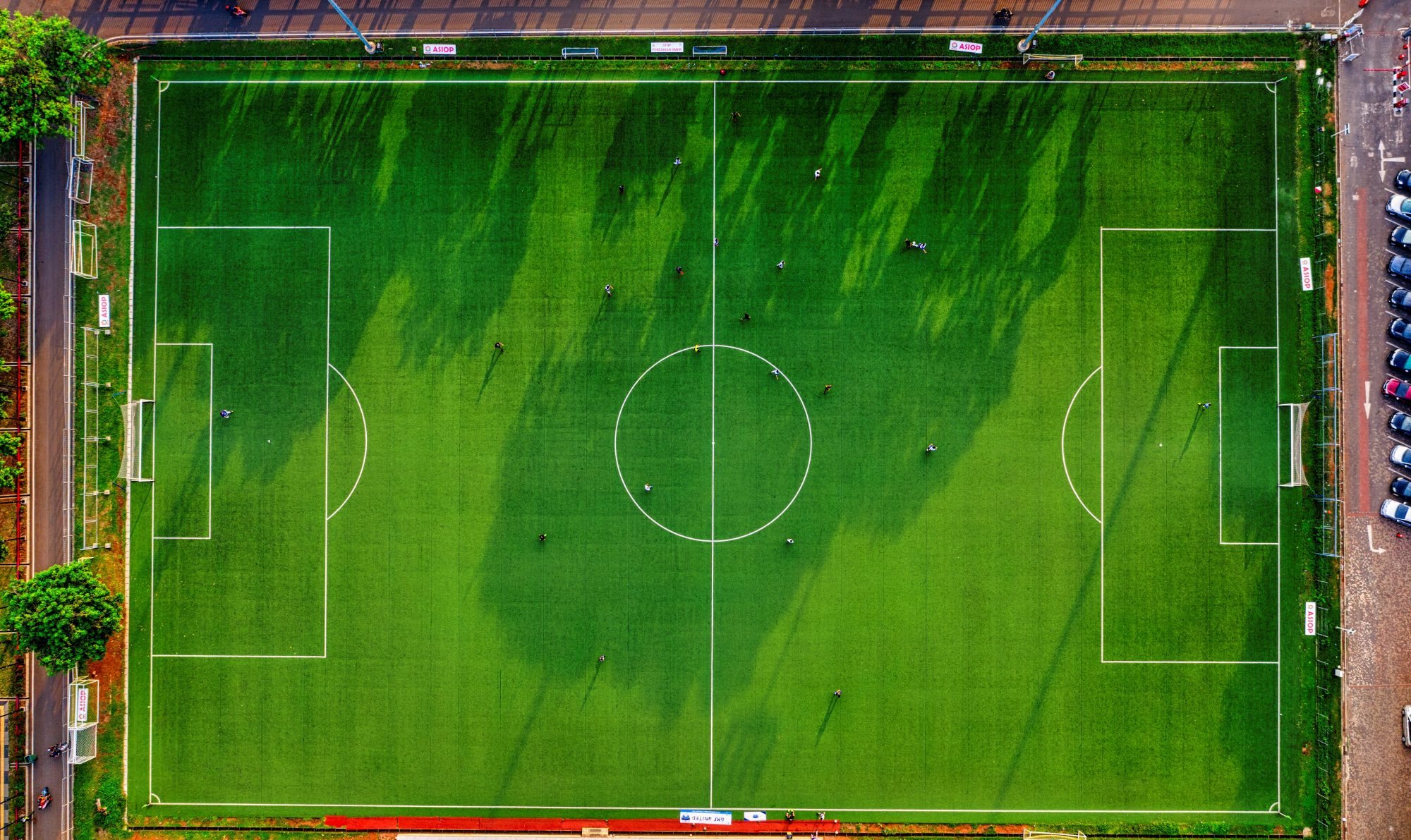
5 thoughts on “Roberto De Zerbi – Brighton – Tactical Analysis”